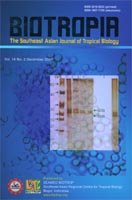
Tags
ASPERGILLUS FLAVUS INFECTION AND AFLATOXIN CONTAMINATION IN PEANUTS AT VARIOUS STAGES OF THE DELIVERY CHAINS IN WONOGIRI REGENCY, CENTRAL JAVA, INDONESIA
Content Language : English

As a part of an Australian Centre for International Agricultural Research (ACIAR) project on management of aflatoxin in Indonesia and Australia (PHT 97/017), a survey on pre- and postharvest handling of peanuts at farmer, collector retailer levels, including Aspergillus flavus infection and aflatoxin B1 contamination of peanuts collected in Wonogiri regency, Central Java, was conducted during the harvest period of the wet (February 2003) and dry (June 2003) seasons. Interviews using questionnaires, with farmers, collectors and retailers concerning pre- and post-harvest handling of peanuts were carried out. The moisture contents and physical quality of the peanut kernels were also determined.
During the wet and dry seasons, fresh pod samples were collected from farmer fields (24 samples), dry raw pod samples from collector (24 samples) and raw kernel samples from retailer levels (54 samples). Thus, during each season 102 samples of various kinds of peanuts were collected for analysis.
The A. flavus infection in kernel samples of peanuts collected from retailers were the highest, followed by samples collected from collectors and farmers. The A. flavus infection in kernel samples collected during the dry season was in general lower than in the wet season. It was alarming to note that all most all samples of raw kernel samples collected from retailers were infected by A. flavus during the wet and dry seasons.
In general aflatoxin B1 levels in peanut samples collected in the wet season were higher than the dry season. During the wet and dry seasons, the aflatoxin B1 contents in retailer samples were the highest, followed by those collected from collectors and farmers. During the wet season, around 4, 17 and 33% of peanut samples collected from farmers, collectors and retailers, were respectively contaminated with more than 15 ppb of aflatoxin B1. During the dry season, around 42 and 74% of peanut samples collected from collectors and retailers, were respectively contaminated with more than 15 ppb of aflatoxin B1, while aflatoxin levels in wet raw pod samples collected from farmers were less than 15 ppb. In 2003 Codex Alimentarius Commission has determined a maximum level of total aflatoxins in peanuts intended for further processing at 15 ppb.
Link

This work is licensed under a Creative Commons Attribution-NonCommercial-NoDerivatives 4.0 International License.
